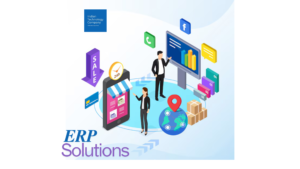Frequent Errors to Sidestep During ERP Implementation
 Enterprise Resource Planning (ERP) systems are designed to assist businesses in streamlining operations, enhancing efficiency and unifying various departments under one platform. However, the process of implementing ERP can be quite complex. Many companies, because of this, tend to commit costly errors that may result in delays, budget overruns, or, in some cases, outright failure. In this text, we will explore the most prevalent ERP implementation mistakes and offer guidance on how to circumvent them.
Enterprise Resource Planning (ERP) systems are designed to assist businesses in streamlining operations, enhancing efficiency and unifying various departments under one platform. However, the process of implementing ERP can be quite complex. Many companies, because of this, tend to commit costly errors that may result in delays, budget overruns, or, in some cases, outright failure. In this text, we will explore the most prevalent ERP implementation mistakes and offer guidance on how to circumvent them.
- Lack of Proper Planning
Mistake:
Numerous businesses hastily embark on ERP implementation without a clearly delineated strategy. Poor planning frequently results in ambiguous goals; this can cause scope creep and misaligned expectations. However, a structured approach might mitigate these issues, although it requires time and effort. Because of this, organizations should prioritize thorough preparation before diving in.
How to Avoid It:
It is essential to clearly define business objectives (1) prior to selecting an ERP system. A detailed needs assessment must be conducted to ascertain the specific requirements of the system. Additionally, develop a realistic timeline and budget for implementation; however, be mindful of potential challenges that may arise during this process. Although some may overlook these steps, they are crucial because they set the foundation for a successful ERP deployment.
- Choosing the Wrong ERP System
Mistake:
Choosing an ERP system that fails to align with the specific needs of a business can lead to inefficiencies (and, consequently) additional costs. However, organizations must carefully evaluate their requirements to avoid such pitfalls. Although it may seem straightforward, this process requires a nuanced understanding of both the system’s capabilities and the unique operational demands of the business. Therefore, failing to consider these factors can ultimately hinder productivity and increase expenses.
How to Avoid It:
Investigate various ERP vendors and evaluate their features. Select an ERP system that aligns with your industry (and) business size. Consider scalability—this is crucial to accommodate future growth. However, be mindful of the specific needs of your organization, because what works for one industry may not be suitable for another. Although the options are numerous, it is essential to make an informed choice, as this decision can significantly impact your operational efficiency.
- Insufficient Training for Employees
Mistake:
Numerous businesses (perhaps mistakenly) underestimate the significance of training; as a result, employees often find themselves grappling with the new system. This lack of preparation can lead to frustration, however, it is essential for effective implementation. Although some may believe that training is unnecessary, it is crucial because it facilitates smoother transitions and enhances overall productivity.
How to Avoid It:
It is essential to provide thorough training both before (and after) implementation. This is crucial for ensuring that all parties involved understand the processes clearly; however, the timing of this training can significantly influence its effectiveness. Although some might argue that only pre-implementation training is necessary, this perspective overlooks the importance of ongoing support. Furthermore, because the environment continually evolves, regular updates to training can enhance adaptability. Therefore, it is vital to approach training as a continuous endeavor, not merely a one-time event.
Offer ongoing support to address challenges.
Fostering user feedback is essential for enhancing training programs; however, one significant obstacle is the lack of a dedicated ERP implementation team. This absence can lead to various challenges in the deployment process, because without a focused group to manage the transition, issues may arise. Although many organizations recognize the importance of user engagement, they often overlook the need for specialized teams to facilitate these changes. Nonetheless, addressing this gap is crucial for success.
Mistake:
In the absence of a dedicated team to oversee ERP implementation, businesses (and their processes) may encounter confusion and a notable lack of accountability. However, this can lead to significant challenges; organizations often find themselves struggling to maintain clarity. Although it might seem manageable at first, the repercussions can be substantial because misalignment often results in inefficiencies. Thus, it is imperative that firms prioritize the establishment of a competent leadership team for such initiatives.
How to Avoid It:
Designate a project manager to supervise the implementation process; this is crucial for success. Formulate a cross-functional team that encompasses representatives from various departments (because diversity fosters innovative solutions). Clear communication must be maintained among all stakeholders, however, it can often be challenging to achieve. Although this may seem straightforward, it requires continuous effort and attention to detail.
- Ignoring Data Migration Issues
Mistake:
Inadequate data migration can result in lost, inaccurate, or even duplicate records; this ultimately hampers the performance of the ERP system. However, organizations must recognize the significance of this issue, because it can have far-reaching consequences. Although some may underestimate the impact, the reality is that effective data management is crucial for optimal functionality.
How to Avoid It:
It is essential to clean (and validate) existing data prior to migration; however, many overlook this critical step. This process not only ensures accuracy but also mitigates potential issues down the line. Although it may seem time-consuming, it is imperative because the integrity of the migrated data relies heavily on the quality of the original dataset. Therefore, taking the time to address these concerns will ultimately yield better results.
Conduct data backups to prevent loss.
Utilize automated data migration tools (such as those designed for efficiency) to reduce the occurrence of errors; however, one must remain vigilant. This approach can be effective, but it is essential to verify the accuracy of the output. Although the tools are beneficial because they streamline the process, human oversight is still critical. Therefore, a balanced strategy is important for optimal results.
- Over-Customization of the ERP System
Mistake:
Excessive customization (1) can result in elevated costs; compatibility issues may arise and long-term maintenance challenges become more pronounced. However, some argue that the benefits can outweigh these drawbacks. Although customization is often desired, it may present unforeseen difficulties because of its complexity. This is a critical consideration in any decision-making process.
How to Avoid It:
Utilize the default settings whenever feasible (however, customization may be necessary) to achieve tangible business advantages. Collaborate closely with the ERP vendor to prevent superfluous modifications. Furthermore, one must remember: failing to conduct thorough testing of the system before going live can lead to significant issues. Although it might seem tempting to rush, this critical step is essential (because it ensures a smoother transition and minimizes disruptions).
Mistake:
Omitting the testing phase (which is crucial) can result in unforeseen errors, system crashes and significant disruptions in operations. However, many may underestimate the importance of this phase. Although it might seem like a time-saving measure, it often leads to greater complications. Because of this, it is essential to prioritize thorough testing. Systematic evaluation is not merely a suggestion; it is a necessity for maintaining operational integrity.
How to Avoid It:
Engage in various testing phases—such as unit testing, system testing and user acceptance testing. It is crucial to allow end-users (who are pivotal) to assess the system in real-world scenarios. However, this process can be complex; it requires careful planning and execution. Although each phase serves a distinct purpose, they collectively ensure the reliability of the system. Because of this, thorough testing is essential for successful implementation.
Fix issues before the full-scale rollout.
- Lack of Change Management
Mistake:
Resistance from employees can result in implementation failure (a significant issue) if appropriate change management strategies are not established. However, this resistance may arise for various reasons—employees might feel uncertain or insecure about the changes being presented. Although management may have good intentions, the lack of a structured approach can exacerbate these feelings. Therefore, it is essential to address the concerns of the workforce, because their support is crucial for successful implementation.
How to Avoid It:
Effectively communicating the benefits of the ERP (Enterprise Resource Planning) system to employees is crucial. Involve key stakeholders (such as department heads) early in the process; this can foster greater acceptance. However, it is important to offer incentives and support, because such measures can significantly encourage adoption. Although some may be resistant, understanding the advantages may help alleviate concerns.
- Ignoring Post-Implementation Support
Mistake:
The implementation of an ERP system does not conclude with the go-live phase; rather, it requires ongoing attention. Many businesses, however, neglect to offer continuous support and adequate system maintenance (this can lead to significant issues). Although the initial deployment may seem successful, the absence of regular updates and troubleshooting can result in diminished performance over time. Because of this, it is crucial for companies to prioritize long-term strategies for sustaining their ERP systems.
How to Avoid It:
Establish a help desk or support team.
Monitor system performance (constantly) and gather user feedback. Schedule regular software updates; this is essential for maintenance. However, one must consider the timing of these updates, because they can disrupt user activity. Although maintenance may seem tedious, it is crucial for optimal performance.
- Underestimating Costs
Mistake:
Numerous companies establish budgets that are often unrealistic (1), failing to adequately account for hidden costs. These costs can include training, maintenance and future upgrades. However, this oversight can lead to significant financial strain. Although companies may believe they have planned effectively, the reality is that unforeseen expenses often arise. This can create challenges, but it is essential to consider all potential factors to ensure a more accurate financial forecast.
How to Avoid It:
Develop a comprehensive budget that incorporates (not just estimates) contingency funds. It is crucial to consider long-term expenses (such as licensing, support and scalability) because these factors can significantly impact your financial planning. Negotiate with ERP vendors for pricing that is flexible; however, be aware of the potential for hidden costs. Although this process may be challenging, it can lead to more sustainable outcomes in the long run.
FAQs About ERP Implementation
- What is ERP implementation?
The implementation of an ERP (Enterprise Resource Planning) system involves several critical steps: installing, configuring and integrating the software into a business’s operations. This process aims to streamline operations and enhance overall efficiency. However, challenges may arise during each phase of implementation, because businesses often have unique needs. Although the goal is to create a cohesive system, it can sometimes be difficult to achieve full integration. Thus, careful planning and execution are essential for success.
- How long does ERP implementation take?
The timeline (which varies) is contingent upon the size and complexity of the business: it can take anywhere from a few months to (potentially) over a year. However, this duration is not fixed; because of differing factors, it may extend or shorten. Although many assume a standard timeframe, the reality is that each case is unique.
- How do I choose the right ERP system?
Identify your business needs.
Compare different ERP vendors.
Select a system that provides scalability and features tailored to specific industries. However, why is employee training crucial in the implementation of ERP systems?
Without adequate training, employees might encounter difficulties in utilizing the system effectively, which can result in decreased productivity and an increase in errors. Additionally, what are the major challenges faced during ERP implementation? Although there are many, this process can often be fraught with complications.
Resistance to change
High costs
Data migration issues
Poor planning
Lack of user adoption
- How can I ensure a smooth ERP transition?
Conduct thorough planning.
Provide adequate training.
Involve key stakeholders early on.
Test the system before full deployment.
- What happens after ERP implementation?
Post-implementation activities include:
Monitoring system performance
Providing ongoing support
Making necessary updates and improvements
- Can a small business benefit from ERP?
Indeed, ERP systems assist small businesses in automating tasks, enhancing efficiency and expanding operations. However, if employees show resistance to adopting the new ERP system, the following steps may be useful: first, engage with them to understand their concerns. This can clarify the benefits of the system, which might alleviate their apprehensions. Second, provide adequate training and support, as employees often resist change because they feel unprepared. Although it may take time, fostering a positive attitude towards the new system can lead to greater acceptance. 9. What should I do if employees resist using the new ERP system?
Educate them on the benefits.
Involve them in the implementation process.
Provide hands-on training and support.
- How often should I update my ERP system?
Consistent updates are essential for maintaining the security, functionality and alignment of the system with business growth. It is advisable to consult your vendor regarding suggested update schedules. However, by steering clear of these frequent errors and adhering to best practices, businesses can effectively implement an ERP system and optimize its advantages. Although it may seem daunting, this approach is vital for long-term success. Because of the complexities involved, attention to detail is crucial in this process.






